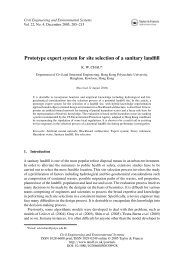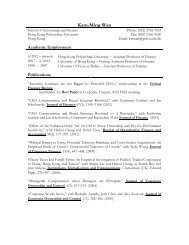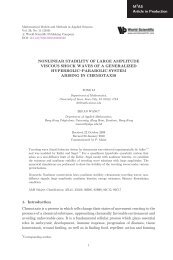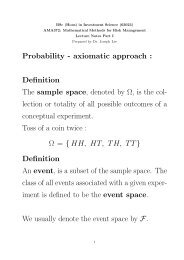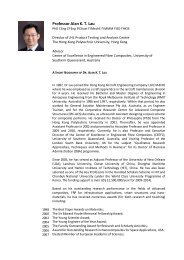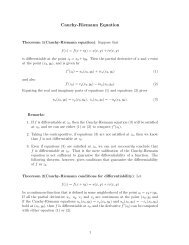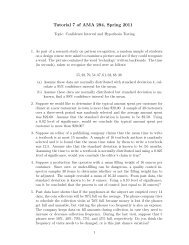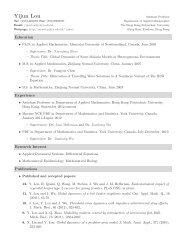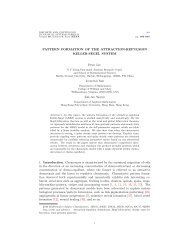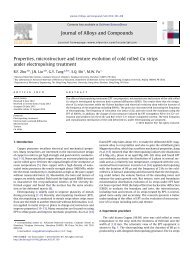DETERMINANTS AND EIGENVALUES 1. Introduction Gauss ...
DETERMINANTS AND EIGENVALUES 1. Introduction Gauss ...
DETERMINANTS AND EIGENVALUES 1. Introduction Gauss ...
You also want an ePaper? Increase the reach of your titles
YUMPU automatically turns print PDFs into web optimized ePapers that Google loves.
2. DEFINITION OF THE DETERMINANT 77Example 4. We shall calculate the determinant of a 4 × 4 matrix. You shouldmake sure you keep track of which elementary row operations have been performedat each stage.⎡⎤ ⎡⎤ ⎡⎤1 2 −1 1 1 2 −1 1 1 2 −1 1⎢ 0 2 1 2⎥⎢ 0 2 1 2⎥⎢ 0 2 1 2⎥det ⎣⎦ = det ⎣⎦ = det ⎣⎦3 0 1 1 0 −6 4 −2 0 0 7 4−1 6 0 2 0 8 −1 3 0 0 −5 −5⎡⎤ ⎡⎤1 2 −1 11 2 −1 1⎢ 0 2 1 2⎥⎢ 0 2 1 2⎥= −5 det ⎣⎦ = +5 det ⎣⎦0 0 7 40 0 1 10 0 1 10 0 7 4⎡⎤1 2 −1 1⎢ 0 2 1 2⎥= +5 det ⎣⎦.0 0 1 10 0 0 −3We may now use the recursive definition to calculate the last determinant. In eachcase there is only one non-zero entry in the first column.⎡⎤1 2 −1 1 ⎡⎢ 0 2 1 2⎥det ⎣⎦. = 1 det ⎣ 2 1 2⎤0 1 1⎦0 0 1 10 0 −30 0 0 −3[ ]1 1=1·2 det =1·2·1 det [ −3]0 −3=1·2·1·(−3) = −6.Hence, the determinant of the original matrix is 5(−6) = −30.The last calculation is a special case of a general fact which is established inmuch the same way by repeating the recursive definition.⎡⎤a 11 a 12 a 13 ... a 1n0 a 22 a 23 ... a 2ndet0 0 a⎢33 ... a 3n⎣..⎥. ....⎦ = a 11a 22 a 33 ...a nn .0 0 0 ... a nnIn words, the determinant of an upper triangular matrix is the product of its diagonalentries.It is important to be able to tell when the determinant of an n × n matrix Ais zero. Certainly, this will be the case if the first column consists of zeroes, andindeed it turns out that the determinant vanishes if any row or any column consistsonly of zeroes. More generally, if either the set of rows or the set of columns is alinearly dependent set, then the determinant is zero. (That will be the case if therank r



